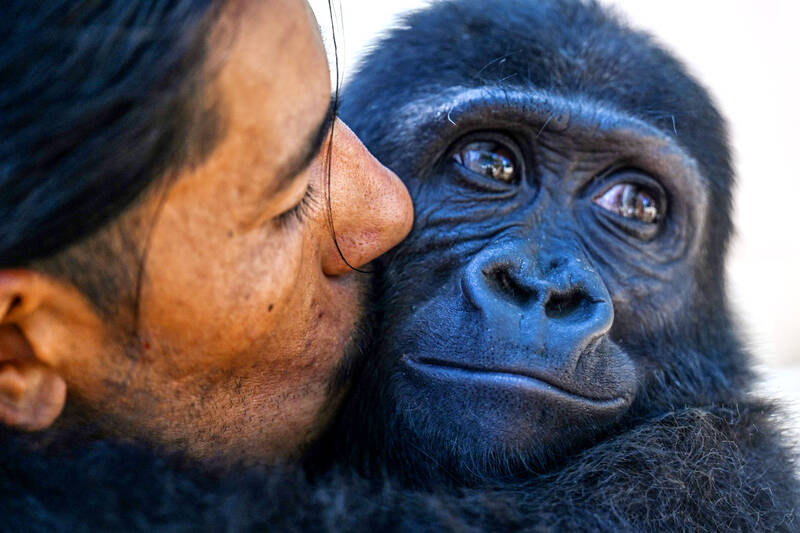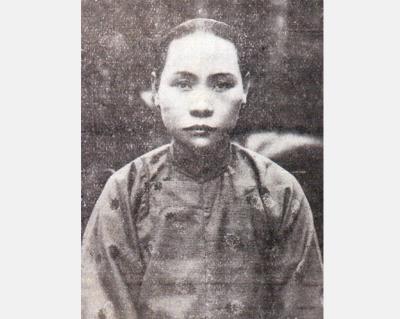Sept. 24 is observed as World Gorilla Day. It was launched in 2017 to coincide with the 50th anniversary of the establishment of a Rwanda-based gorilla study center founded by Dian Fossey, the American primatologist and conservationist who gained global renown for her research.
The gorillas Fossey studied and looked after were mountain gorillas that belong to the species known as the eastern gorilla and live mostly in the Virunga Massif, a mountainous area encompassing parts of Congo, Rwanda and Uganda. The second species, known as the western gorilla, inhabits areas of west and central Africa.
Gorillas are losing their habitat because of poaching and other threats. The International Union for Conservation of Nature lists both gorilla species as endangered, with three of four subspecies critically endangered.

Photo: AFP
Here are some things to know about the great apes:
KINSHIP WITH HUMANS
Humans share much of their DNA with gorillas, and scientists cite figures showing up to 98 percent similarity.
“Gorillas are humans’ closest living relatives after chimpanzees, and are of comparable importance for the study of human origins and evolution,” according to the science journal Nature. This kinship with humans is one reason gorillas are susceptible to infections spread through close contact with tourists, researchers and others who come near them. Gorillas are especially vulnerable to the influenza virus, and respiratory illnesses are a frequent cause of death among adult gorillas.
Visitors tracking gorillas in the wild are usually urged to stand at least 7 meters from the primates — as well as not to touch them even if they wander, as they sometimes do, closer to people. In her lifetime, Fossey worried that gorilla tourism was injurious to the well-being of gorillas because it might alter their behavior in the wild, but tourism-driven gorilla conservation projects in countries such as Uganda has proved successful over the years.
FAMILY IS FAMILY
Gorillas in the wild live in families, with the dominant male — known as the silverback because of the patch of silvery fur on his back — as the head of the group. He can co-exist with younger males, who defer to him, as well as many females, juveniles and infants.
Uganda’s Bwindi Impenetrable National Park, home to many of the world’s remaining gorillas, has 27 families considered “habituated,” trained to appear comfortable in the presence of humans. Most silverbacks are known to be protective of their families. The silverback in one of the Bwindi families is named Murinzi, a local word for “protector,” because rangers have seen him to be quite solicitous.
To assert their authority, silverbacks sometimes stand on their hind legs, beat their chests and vocalize, sending younger males in flight and warning rivals from other groups. Gorilla mothers are just as generous with their offspring, and the “love they show for their youngsters is undeniably deep and evident to everyone lucky enough to observe it,” according to the Dian Fossey Gorilla Fund, a charity working to protect the primates. Gorillas can live for over 40 years in the wild.
THREATS TO HABITAT
The powerful majesty of gorillas in the wild is one reason they fascinate tourists. But while they are the largest living primates, they can also seem gentle and meek. An average silverback can weigh up to 180kg. Herbivorous creatures, gorillas eat mostly leaves and the shoots and stems of plants. They may also eat ants and snails.
The International Gorilla Conservation Program says the main threat to gorillas is habitat loss from the clearance of the forested ecosystems they inhabit. “Conversion of land for agriculture and competition for limited natural resources such as firewood lead to varying degrees of deforestation,” according to the group, a coalition of conservation nonprofits focusing on the survival of mountain gorillas.

Dec. 8 to Dec. 14 Chang-Lee Te-ho (張李德和) had her father’s words etched into stone as her personal motto: “Even as a woman, you should master at least one art.” She went on to excel in seven — classical poetry, lyrical poetry, calligraphy, painting, music, chess and embroidery — and was also a respected educator, charity organizer and provincial assemblywoman. Among her many monikers was “Poetry Mother” (詩媽). While her father Lee Chao-yuan’s (李昭元) phrasing reflected the social norms of the 1890s, it was relatively progressive for the time. He personally taught Chang-Lee the Chinese classics until she entered public

Last week writer Wei Lingling (魏玲靈) unloaded a remarkably conventional pro-China column in the Wall Street Journal (“From Bush’s Rebuke to Trump’s Whisper: Navigating a Geopolitical Flashpoint,” Dec 2, 2025). Wei alleged that in a phone call, US President Donald Trump advised Japanese Prime Minister Sanae Takaichi not to provoke the People’s Republic of China (PRC) over Taiwan. Wei’s claim was categorically denied by Japanese government sources. Trump’s call to Takaichi, Wei said, was just like the moment in 2003 when former US president George Bush stood next to former Chinese premier Wen Jia-bao (溫家寶) and criticized former president Chen

Politics throughout most of the world are viewed through a left/right lens. People from outside Taiwan regularly try to understand politics here through that lens, especially those with strong personal identifications with the left or right in their home countries. It is not helpful. It both misleads and distracts. Taiwan’s politics needs to be understood on its own terms. RISE OF THE DEVELOPMENTAL STATE Arguably, both of the main parties originally leaned left-wing. The Chinese Nationalist Party (KMT) brought together radicals, dissidents and revolutionaries devoted to overthrowing their foreign Manchurian Qing overlords to establish a Chinese republic. Their leader, Sun Yat-sen

Late one night in April 2020, towards the start of the COVID lockdowns, Shanley Clemot McLaren was scrolling on her phone when she noticed a Snapchat post by her 16-year-old sister. “She’s basically filming herself from her bed, and she’s like: ‘Guys you shouldn’t be doing this. These fisha accounts are really not OK. Girls, please protect yourselves.’ And I’m like: ‘What is fisha?’ I was 21, but I felt old,” she says. She went into her sister’s bedroom, where her sibling showed her a Snapchat account named “fisha” plus the code of their Paris suburb. Fisha is French slang for